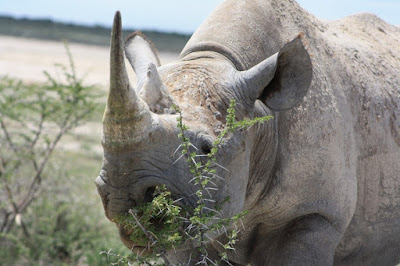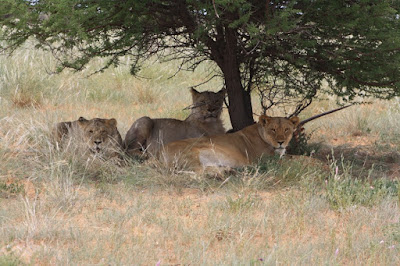Windhoek
– Victoria Falls und zurück
TEIL 3 – im Etosha Nationalpark
Wir haben jetzt noch zwei volle Tage innerhalb des Etosha Nationalparks zur Verfügung. Schon gestern haben wir die Gegend westlich der Etosha-Pfanne erkundet, aber eben nur soweit es unser Zeit-Budget zulässt. Wir haben schließlich danach noch einiges vor uns. Zurück, an Okaukuejo vorbei und dann nochmals gute siebzig Kilometer in östlicher Richtung bis zum Halai-Camp.
Wenn das irgendwie möglich ist, dann nehme ich mir im östlichen Teil des Nationalparks immer soviel Zeit, dass wir von Fort Namutoni aus auch die Gegend östlich der Etosha-Pfanne und um die Fischer-Pfanne herum erkunden können.
Wie schon in TEIL 2 unserer Tour beschrieben, sind wir durch das Andersson-Tor in den Nationalpark gekommen, haben unsere Permits bezahlt und die Unterkünfte bestätigt, die wir natürlich schon im Voraus gebucht hatten.
Okaukuejo, Halali und auch Fort Namutoni, wurden von der deutschen Schutzgebietsverwaltung als Militär- und Polizeiposten errichtet, dienten aber nur sekundär, militärischen Zwecken. Hauptaufgabe war die Eindämmung der Maul- und Klauenseuche. Als Kommunikationsmittel dienten sogenannte Heliogtaphen-Stationen, die in Okaukuejo und Namutoni auf hohen Aussichtstümen errichtet wurden und nahe dem Halali Camp, auf einem Granit-Hügel. Das Sonnenlicht wurde durch eine Linse gebündelt, womit man dann optische Morse-Signale senden konnte.
Direkt neben dem Halali-Camp liegt noch ein weiterer, kleinerer Granithügel, von dem aus man ein künstliches Wasserloch Tag und Nacht beobachten kann.
<<< Etosha-Aussichtpunkt - auf einer Halbinsel.
 |
So ist das Leben - auch den Leoparden "erwischt es" ...irgendwann auch mal....
|
Die Etosha-Salzpfanne war ursprünglich ein riesiger
See von etwa 4.760 Quatratkilometern, der langsam austrocknete. Auch heute
noch kann sich die Pfanne in einer starken Regensaison komplett mit Wasser
füllen, was sehr selten geschieht und auch nur noch geringe Wassertiefen
verursacht. Der Name Etosha bedeutet auf Ojiwambo „Großer Weißer Platz“, was
darauf hindeutet, dass dieser See schon seit der Zuwanderung von Bantu-Völkern
ausgetrocknet war.
Die Pfanne liegt auf rund eintausend Höhenmetern und ist Teil der
Kalahari-Senke, die sich über weite Teile Botswanas und den Osten- und
Norden Namibias erstreckt. Zusammen mit dem Cuvelai-Wassereinzugssystem
und dem Opono-See bildet diese ein besonderes Feuchtgebiet im Sinne der
„Ramsar-Konvention“.
 |
| Steinböckchen
und Giraffe |
Als erste Europäer kamen im Jahr 1851 der
schwedische Forschungsreisende John Charles Andersson und der englische
Wissenschaftler Francis Galton in die Gegend und veröffentlichten Ihre
Reiseberichte, die diese Salzpfannen in Europa bekannt machten.
Etwas später, in den 1860er Jahren zogen auch
Gruppen von „Dorslandtrekkern“ (Durstland-Trecker)
von Transvaal herkommend auf ihrem Weg in Richtung Angola durch- und entlang
der Salzpfannen. 1876 reiste dann auch noch der amerikanische
Handelsreisende Gerald McKiernan durch die Namib und erreichte die
Etosha-Pfanne, wobei er in Okaukuejo Süßwasserquellen entdeckte.
<<< Spitzmaulnashorn in der Andoni-Ebene
Das Spitzmaulnashorn ernährt
sich vorwiegend von Blättern, kleinen Ästen, Zweigen und Rinde. Im Gegensatz
zum Breitmaulnashorn, frist es Gräser nur in Ausnahmefällen. Im Etosha Nationalpark
sind die verschiedenen Akazienarten Haupt-Nahrungsgrundlage.
Das Spitzmaulnashorn
bevorzugt gute Deckung im dichten Busch und lebt vor allem dämmerungs- und
nachtaktiv.
Breitmaulnashörner kommen im Etosha Nationalpark nur Gebietsweise vor. Vor allem wohl deshalb, weil dort größere Grasflächen nur in der Regenzeit zu finden sind.
Die Löwenpopulation wird derzeit auf etwa 400 bis 450 Tiere geschätzt, die sich über die gesamte Fläche des Nationalparks verteilen.
Löwen sind zwar auch tagsüber anzutreffen, jagen aber überwiegend nachts. Wobei Sie ihren größten Vorteil ausnützen können, das hervorragende Sehvermögen bei Dunkelheit.
Auch heute hat es sich gelohnt, dass wir am späteren Nachmittag noch eine Runde um die Fischerpfanne herum gefahren sind... - siehe hier:
<<< Löwen-Mädels am Aroel-Wasserloch
Morgen früh werden wir noch eine Runde in Richtung des Klein-Namutoni Wasserlochs und den Dik-Dik Drive entlang fahren. Danach geht es dann über Tsumeb und Grootfontein weiter in Richtung Rundu... - am Okavango. Das gegenüberliegende Ufer gehört bereits zu Angola.
 |
| Fort Namutoni - abends der Blick vom Aussichtsturm und der Blick auf das Fort am frühen Morgen. |
Wir beschreiben in diesem Blog nicht nur die Tour selbst
und was wir dabei erlebt haben. Wir wollen damit auch über Naturschutzaspekte,
die Entstehungsgeschichte der Nationalparks und über aktuelle Ereignisse im
Zusammenhang damit berichten. Auch die Geologie der jeweiligen Landschaften und
deren erdgeschichtliche Grundlagen spielen dabei eine wichtige Rolle.
Klar – wir können in diesem Rahmen nicht alles ausführlich behandeln. Deshalb
meine Bitte: Schreibt in die Kommentar-Spalte, eure persönlichen Fragen, welche
Themen euch besonders interessieren und worüber wir mehr schreiben sollten.
Diesen Themenkreisen haben wir auch zwei Blätter auf
unserer Internet-Seite gewidmet – nämlich:
- Naturschutz und Jagd....>>>
- ....sowie Naturschutz und Tourismus...>>>


















